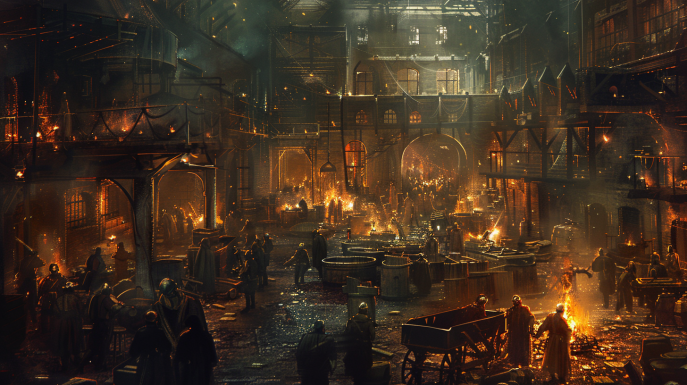Introduction
The English Civil War, a period of intense conflict between Parliamentarians and Royalists, led to significant upheavals in British history. Among the many dramatic changes of the era was the fate of King Charles I’s Crown Jewels. These treasures, once symbols of royal power and prestige, were melted down or sold off by Parliamentarians following the king’s execution. Some believe that hidden pieces still exist, waiting to be discovered.
The Historical Context
The English Civil War, spanning from 1642 to 1651, was a series of armed conflicts and political machinations between Parliamentarians (Roundheads) and Royalists (Cavaliers). It was a struggle over governance and the role of the monarchy, culminating in the trial and execution of King Charles I in 1649. This period saw the rise of Oliver Cromwell and the temporary abolition of the monarchy.
The Importance of the Crown Jewels
The Crown Jewels are not just ornamental; they are imbued with deep symbolism and historical value. They represent the continuity and legitimacy of the monarchy, used in coronations and other significant state ceremonies. Their loss or destruction would be a profound statement against the institution they represent.
Charles I’s Crown Jewels
During the reign of Charles I, the Crown Jewels included magnificent crowns, scepters, orbs, and other regalia, each piece meticulously crafted and rich with gemstones. These jewels were integral to the visual and ceremonial representation of the king’s authority and divine right to rule.
The Fall of King Charles I
The downfall of Charles I was a gradual process, marked by escalating tensions between the monarchy and Parliament. His refusal to concede to parliamentary demands led to open conflict. The eventual defeat of Royalist forces and the king’s subsequent capture and trial culminated in his execution on January 30, 1649, an unprecedented event in English history.
Parliamentarians’ Actions Post-Execution
After the execution of Charles I, the Parliamentarians swiftly moved to dismantle the symbols of the monarchy. This included the confiscation of the Crown Jewels. Parliament, now wielding unprecedented power, decided to erase these emblems of royal authority.
Melting Down of the Crown Jewels
The decision to melt down the Crown Jewels was both practical and symbolic. By destroying these items, the Parliamentarians aimed to obliterate the remnants of monarchical rule. Gold and silver from the regalia were melted and converted into coins and other forms of currency, funding the new Commonwealth government.
Sale of the Crown Jewels
While many pieces were melted down, some jewels were sold to raise funds. The auctioning of these treasures attracted buyers from across Europe, eager to own a piece of history. Notable transactions included the sale of valuable gems and intricate items of regalia to wealthy merchants and nobles.
Legends and Myths
Despite the thoroughness of the Parliamentarians, legends persist about hidden pieces of the Crown Jewels. Stories abound of loyalists who managed to conceal items before they could be confiscated. These tales add a layer of mystery and intrigue to the history of the Crown Jewels.
Historical Accounts and Evidence
Historical records and documents from the period provide detailed accounts of the fate of the Crown Jewels. These include inventories, sale records, and parliamentary decrees. Such documents are crucial for historians piecing together the events of that tumultuous time.
Impact on British History
The destruction and dispersal of the Crown Jewels had immediate and long-term effects on British history. In the short term, it marked the definitive end of the reign of Charles I and the temporary abolition of the monarchy. Long-term, it left a gap in the continuity of royal symbols, which had to be addressed when the monarchy was restored in 1660.
Modern-Day Discoveries
Over the years, there have been occasional reports of discoveries of items believed to be part of the original Crown Jewels. These findings, often sensationalized, spur interest and investigations. While most such claims are unsubstantiated, they keep the hope alive that some pieces might still be out there, hidden away.
Cultural Significance Today
The story of the Crown Jewels during the English Civil War continues to capture the public’s imagination. It is a narrative of power, rebellion, and loss that resonates through various forms of media, from historical novels to documentaries. The allure of hidden treasures waiting to be discovered adds to the cultural richness of the tale.
Conclusion
The English Civil War was a defining moment in British history, and the fate of the Crown Jewels is a poignant chapter within it. Melted down or sold off by the Parliamentarians, these treasures symbolized the end of one era and the challenging birth of another. The legends of hidden jewels and the ongoing search for them add a fascinating dimension to this historical saga.
FAQs
What happened to the Crown Jewels after the Civil War?
After the Civil War, many of the Crown Jewels were melted down by the Parliamentarians to fund the new government. Some pieces were sold to raise money.
Are there any pieces of the Crown Jewels still missing?
While most of the Crown Jewels were accounted for, legends persist that some pieces were hidden and remain undiscovered.
How were the Crown Jewels melted down?
The Crown Jewels were melted down in furnaces, and the precious metals were converted into coins and other forms of currency.
Who bought the Crown Jewels during the Civil War?
Wealthy merchants and nobles from across Europe purchased some of the Crown Jewels when they were sold off by the Parliamentarians.
What is the current status of the Crown Jewels?
The current Crown Jewels, created for the coronation of Charles II, are housed in the Tower of London and remain a vital symbol of the British monarchy.

